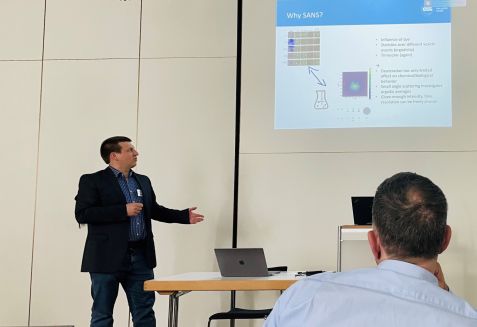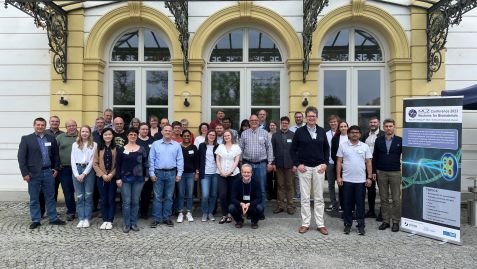MLZ is a cooperation between:
 > Technische Universität München
> Technische Universität München > Helmholtz-Zentrum Hereon
> Helmholtz-Zentrum Hereon
 > Forschungszentrum Jülich
> Forschungszentrum Jülich
MLZ is a member of:
 > LENS
> LENS > ERF-AISBL
> ERF-AISBL
MLZ on social media:

MLZ (eng)
Lichtenbergstr.1
85748 Garching
30.06.2023
MLZ Conference 2023: Neutrons for Biomaterials
For the MLZ Conference 2023 more than 50 conference participants met at Schloss Fürstenried from May 22 to 25. A total of 44 speakers discussed the application of neutrons in biomaterials research. Exciting lectures were given about the SARS-CoV-2 fusion process and new possibilities for cancer therapy.
On the second day of the conference, Dr. Hermis Iatrou, from the University of Athens, opened the round of lectures. He studied a hydrogel consisting of amino acids using neutrons. The protein components are the basis for the gel’s action and neutrons have elucidated the exact structure. Hermis Iatrou said, “Studies have already confirmed its therapeutic effect in treating cancer.”
Dr. Regine Willumeit-Römer of the Helmholtz Center Hereon spoke about another medical topic: ‘Degradable metallic implants: Details of the Magnesium-Bone Interface.’ In the future, this could be used to surgically stabilize bone fractures, for example, without having to remove the material afterwards. The degradation of the metal magnesium could even strengthen bone formation in the process. “To understand the processes involved, we use neutrons,” explained Regine Willumeit-Römer.

Dr. Sebastian Jaksch explaining the measurement of the fusion rate of SARS-CoV-2 and the human ACE2 receptor. © FRM II / TUM
What makes SARS-CoV-2 so aggressive?
A significant factor in the aggressiveness of SARS-CoV-2 is the fusion of the pathogen’s spike protein with the human ACE2 receptor. But how fast is this fusion? This question was addressed by the research team led by Dr. Sebastian Jaksch from the European Spallation Source. The indicator of fusion during the experiment is a change in the contrast of the solution. Using neutron small-angle scattering (SANS), Jaksch’s results showed, “The fusion is so fast, it takes less than 10 seconds.”
They were also able to prove that the SARS-CoV-2 spike protein is responsible for this effect. This is because if the experiment is repeated with a mutant that does not produce a spike protein, the fusion speed is slower by a factor of 2500.
However, it remains unknown, how many seconds the process takes exactly.
Opportunity for lively exchange
Questions that remained open after the presentations were discussed by the participants during the coffee breaks, lunch or dinner. The poster exhibition following the presentations also promted conversations and discussions. Organizer of the conference and senior scientist at Forschungszentrum Jülich, Dr. Stefano Pasini, thanked all participants for their very professional presentations. “This event shows the potential neutrons can have for the characterization and development of biomaterials. We all took away a lot and look forward to further collaborations.”
MLZ is a cooperation between:
 > Technische Universität München
> Technische Universität München > Helmholtz-Zentrum Hereon
> Helmholtz-Zentrum Hereon
 > Forschungszentrum Jülich
> Forschungszentrum Jülich
MLZ is a member of:
 > LENS
> LENS > ERF-AISBL
> ERF-AISBL
MLZ on social media:




